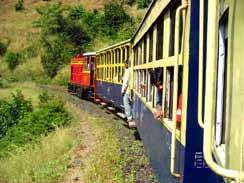
5 minute read
Tourism – Hill Station Train
from SBI Second Innings Sept 2019 issue carries Life and Career of Prof Dr Chowdari Prasad in 11-12 pages
Darjeeling Himalayan Railway - DHR Riding the Toy Train of Darjeeling Himalayan Railways (DHR) has always remained a coveted experience to the tourists. Only few would let go such an opportunity and there is a clear reason why so. After all this Toy Train has been accorded the UNESCO World Heritage status and that's for a special reason. Operating on narrow gauge tracks since 1880s and providing an important transport link to various parts of Darjeeling hills and lower plains, the toy train is an icon of our heritage since the colonial days and an engineering marvel that was achieved in that era. It also offers a wonderful way of absorbing the Himalayan beauty as you traverse along the slopes of the hills. Where else can you find a small steam engine pulling mini coaches up the steep mountains through breathtaking landscapes and overcoming almost impossible curves and gradients using sheer engineering ingenuity and creative skills. The snail pace at which the train moves through the hilly terrain is at times so slow that you can often see the local school children hopping on and off the train on the move. Although the diesel engines used these days are faster and more powerful, the original steam engines still operate in some sections also for joyrides. The steam loco drawn trains sometimes tend to skid in steep gradients. You can often see an attendant standing in front of the engine and sprinkling sand on the track to overcome such difficulties, particularly in monsoon time. Toy Train Joyride - Darjeeling to Ghum & Back
Toy train joy rides operate from Darjeeling Railway Station. It's a 2-hour round trip from Darjeeling up to Ghum and back covering a total distance of 14kms. There are several such round trips during the day starting in the morning. Number of rides per day depends on the demand during the month or the season. The train stops for 10 minutes at the Batasia Loop. The Darjeeling Himalaya Railway, nicknamed the "Toy Train", is a 2 ft (610 mm) gauge narrowgauge railway from Shiliguri to Darjeeling in West Bengal, run by the Indian Railways. It was built between 1879 and 1881 and is about 86 km long. The elevation level is between about 100 m at Siliguri and about 2'200 m at Darjeeling. The DHR is the very first hill railway in India, and one of the first ones in the world, the “toy train” is operating and retaining most of its original features and values until today. In the mid19th century, the British rulers built a recovery home away from home in the Himalayan city Darjeeling where the stress of colonial rule and the hot Indian climate could be put away for the summer. A sanatorium and a military depot were set up. The soft climate was not only good for recreation but also supporting extensive
Advertisement
tea growing and plantation. Subsequently, Darjeeling became a well-known new British settlement and trading point for tea. Increasing traffic by people and commodities overstressed the existing cart-road and a new transportation system was required. DHR was declared a World Heritage site by UNESCO in 1999, only the second railway to have this honour bestowed upon it, the first one being Simmering Railway of Austria in 1998. To be nominated as World Heritage site on the World Heritage List, the particular site or property needs to fulfill a certain set of criteria, which are expressed in the UNESCO World Heritage Convention and its corresponding Operational Guidelines. Four modern diesel locomotives handle most of the scheduled services; however the daily Kurseong-Darjeeling return service and the daily tourist trains from Darjeeling to Ghum (India's highest railway station) are handled by the vintage British-built B Class steam locomotives. The B class locomotive may be amongst the tiniest on its gauge and the railway is often referred to as a 'Toy Train' by its aficionados but it takes a crew of upto five men to maneuver this mighty machine on its journey up the hills. Apart from the driver and his assistant, there are two men seated on either side of the boiler smokebox just above the buffer beam. Their job is to sprinkle fine sand on the rails, which helps in increasing adhesion between rail and wheels, and avoid slipping and derailment, especially in wet weather. Finally, there is the coal breaker who is perched on top of the coal bunker and helps breaking larger lumps of coal. On the downhill journey, one may spot men between coaches often moving up and down on a lever and relaxing on top of the coaches on the level or uphill sections. These are not joy riders but 'brakes-men' who perform the crucial job of slowing down individual coaches through the operation of mechanical foot brakes. The railway, along with the Nilgiri Mountain Railway and the Kalka-Shimla Railway, is listed as the Mountain Railways of India World Heritage Site. The headquarters of the railway is in the townof Kurseong. India is the land of diverse culture and rich heritage. No wonder UNESCO has identified twenty-six World Heritage Sites here. Each place has fascinating stories to tell. For one such impressive tell, visit Darjeeling in West Bengal and board The Himalayan Toy Train. It is not only an engineering marvel but also a delightful and enjoyable way to soak in the beauty of the passing hills and the dense forests. This eighty-three kilometre long stretch connecting Darjeeling with the railhead of Siliguri will keep you entertained. So, board The Himalayan Toy Train for world’s most exotic train ride.The month of February 2019 was celebrated in DHR as Heritage month. Various events were organised in DHR. A steam special run was organised from Siliguri to Rongtong in February 2015. India Post and many countries has issued postage stamps on DHR. Anil K Saxena Freelancer, Philatelist, Ex Tourist guide, Dept of Tourism, Govt of Bihar Retired Branch Manager, State Bank of India, Gaya, Bihar SHREE RADHA SADAN, HOUSE-273, A.P. COLONY, GAYA-823001 Mob 9431272010 emsaxenaak273@yahoo.co.in








